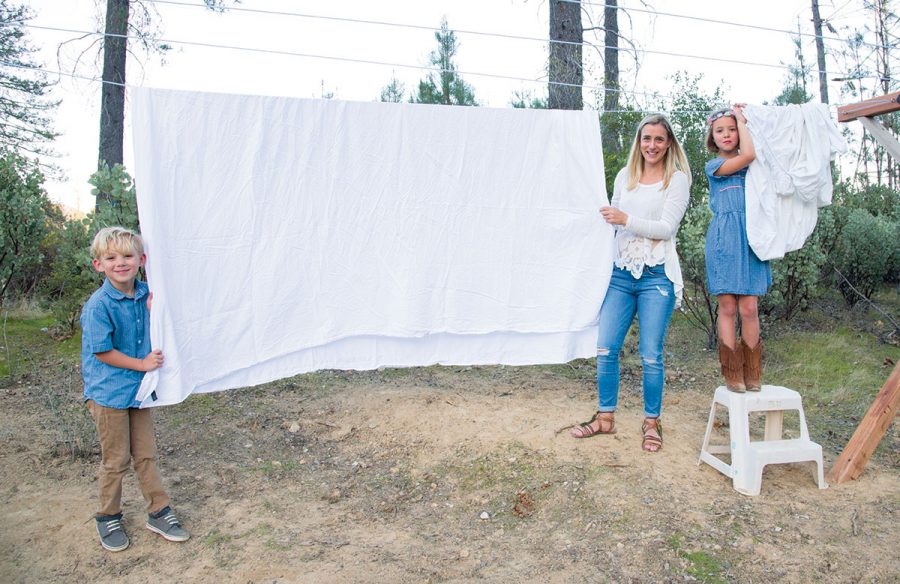Solar Powered Clothes Dryer
Old fashioned and quaint or good green common sense? Air drying your laundry outside in the spring, summer and fall is one of the more efficient and satisfying ways to green your home life. Yay for the solar powered clothes dryer! Installing a clothesline is a home improvement project that doesn’t typically require a professional or a large investment and hanging your clothes in the fresh air won’t seem like a chore after one takes a moment to consider all the benefits this tried and true household task brings.
Practically speaking, the energy efficiency is substantial. In Northern California, electric clothes dryers cost $.25-$.75 per hour to run with an added cost to the environment. The Environmental Protection Agency reports that electric clothes dryers emit a depressing 32 million metric tons of carbon dioxide each year in the United States. Gas dryers are slightly more economical but can make up that difference with the cost of natural gas or propane fuel. Once you’ve purchased and installed your clothesline, drying your laundry is cost-free.
Sunlight is a natural sanitizer and can help with stubborn stains or brightening whites. Diapers, sheets, bath towels and dish towels all reap healthy benefits from drying beneath the sun.
Clothes will last longer if line-dried. Lint is the result of the fabric of your laundry being broken down and pulverized into fibers during heated tumble drying. The usual shrinking culprits, jeans and t-shirts, won’t be a problem when properly hung on a line.
 Organically-dried laundry smells naturally fresh. Constance Anderson has a delightful line in her children’s book, Smelling Sunshine, “I pull up the covers, and smell the sunshine.”
Organically-dried laundry smells naturally fresh. Constance Anderson has a delightful line in her children’s book, Smelling Sunshine, “I pull up the covers, and smell the sunshine.”
It’s nice to get outside for some alone time, or with young children who can be easily watched while you work or taught to shake out clothes and hand them to you; or to send teenagers out of doors with an important household task. Laundry needs to be hung correctly and with care so that towels and sheets don’t drag on the ground or become temptations for pets, and so it dries in a timely manner.
There are tricks and tips to hanging laundry on a line. Hang dark or colorful clothing inside out to prevent fading. Give all laundry a good shake and a snap before hanging to ease out wrinkles. Most clothes should be hung from the bottom to avoid clothespin marks and to keep gravity from pulling items out of shape. Pants and shorts are easier to hang from the cuffs because of the bulky fabric of the waistbands. Some clothes can be hung on a hanger and then hung outside on the line. Overlap items, so that they share clothespins. Some resultant “stiffness” of line-dried laundry can be countered by adding W to X cup of white vinegar to your washing machine instead of a chemical fabric softener. You might also want to experiment with detergents, both the brand and the amount used, as detergent residue can contribute to clothes drying stiffly.
Choosing the type of clothesline you want to install will depend upon the best location to hang your laundry and sometimes where you live. There are various situations such as homeowner’s associations, condominiums, apartments and dormitories that don’t allow residents to hang laundry. In 2016, however, California became a “right to dry” state by putting a law on the books forbidding the banning of hanging out laundry.
T-Posts, umbrellas, pulleys, retractable and rack lines are the more usual choices for line drying. Some lines require installation, while others can be as simple as stringing a length of clothesline from here to there or setting a laundry rack out on your patio.
Of course, line drying can also be accomplished indoors, in inclement weather or because of your housing situation. Laundry racks on tile floors, in a bathtub, in the basement or up in the attic do the trick, albeit more slowly. If you do return to tumble drying your laundry during the winter months, perhaps you will fondly remember warmer days filled with sunshine, hanging a fresh wash out on the line and the sweet smell of air-dried laundry.
- There are health benefits to hanging out the laundry. Experts say you need 15 – 30 minutes of sunlight twice a week to help you get your Vitamin D. Physical exertion is a part of hanging out the laundry, and it elevates your heart rate.
- Sunlight kills some forms of bacteria; a natural sanitizer for your laundry.
- California is a “right to dry” state.
- During winter months, Energy Star certified dryers use about 20 percent less energy than conventional models. Consider using a gas dryer to save on utility costs and reduce environmental impact.
Posted in: Community, Environment
Comment Policy: All viewpoints are welcome, but comments should remain relevant. Personal attacks, profanity, and aggressive behavior are not allowed. No spam, advertising, or promoting of products/services. Please, only use your real name and limit the amount of links submitted in your comment.
You Might Also Like...

California Soccer Park Bringing People Together One Game At A Time
The Field is the Place to Be Soccer is a beloved sport that emphasizes community – something the California Soccer Park in Redding understands well. As the largest soccer park […]

Red Bluff Playgroup Gives Kiddos (and their Parents) a Place to Make New Pals
Mojan Bailey’s son likes to tinker on toy cars with his plastic drill and wrench, but today the 3-year-old takes a break to sit at a toddler table and shape […]
Soaring with Eagle Scouts
Commitment and dedication are traits that you might expect to find in an Eagle Scout, but Ron Zufall has taken those traits to another level with his 41-year relationship with […]
First 5 Commissions: Raising the Bar for Early Childhood Development
Something monumental happened for families in California in 1998. With the passing of The Children and Families First Act (Proposition 10), First 5 California, also known as the California Children […]

Two North State Organizations Focus On Healthy Eyes, Clear Vision
Watching a sunset, seeing the faces of children and loved ones, or the simple view of flower-filled grassy knolls are all pleasures in life that some people risk losing […]

Where Adventure, Dreams, and Inspiration Begin – Raven and the Unicorn Children’s Theater
The Raven and the Unicorn Children’s Theater is a proposed 800-seat theater designed specifically for child-centered performing arts programs and educational opportunities. The theater will be the only Leadership in […]


